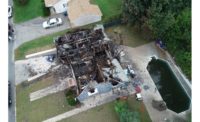My name is Stanley Stewart. Most people know me as “Goose.” I have worked in coal mines for 34 years and at the Upper Big Branch mine for 15 of those years. I have worked as a jack setter and shear operator on the long wall, also worked 3 years on the outby long wall and from January 2009 to April 5, 2010, a continuous miner operator.
I am here to tell my story today because I worked at the Upper Big Branch mine until the day of the accident and was 300 feet underground the day the explosion occurred. Although I did not lose a member of my family, I lost several co-workers, including William Griffith, Ricky Workman, Eddie Mooney, Timmy Davis, Gary Quarles, Rex Mullins and 22 others who were like family to me. I also know firsthand how bad conditions were at the mine and want everyone to know. In fact, last July, I told my wife, Mindi, “If anything happens to me, get a lawyer and sue the [blankety blank] out of them! That place is a ticking time bomb.” Only I didn’t say “blankety blank” to her because I was so scared – and mad! She told me to write down things that were wrong because she wouldn’t know specifics or the terminology to convey what was happening. I began to write down things I knew were illegal or wrong.
On April 5th, I was sitting on a mantrip at about 3 pm with several other miners approximately 300 feet underground. We were getting ready to head to the section when I felt a breeze coming from inside the mine. The intensity picked up quickly and I realized that something bad was happening so I left the mantrip and started making my way toward the outside. Before I could get out the air velocity increased to what I felt was “hurricane strength” and I felt my feet wanting to leave the ground. The air was full of dust debris and I couldn’t see. Although I didn’t have far to go I panicked, afraid that I might not make it out to safety.
Red flagsMany things were wrong at the mine such as low air constantly. The area of the mine we were working was liberating a lot of methane. Mine management never fully addressed the air problem when it would be shut down by inspectors. They would fix it just good enough to get us to load coal again, but then it would be back to business as usual. The long wall worried me because of the ventilation. My experience in the mines showed me that the ventilation system they had didn’t work. And with so much methane being liberated, and no air moving it gave me the feeling that area was a ticking time bomb. I was told prior to the April 5th explosion, that they had experienced at least 2 fireballs on the drum of the shearer. This leads me to believe the methane was indeed building in that area, showing lack of air and ventilation problems. One question that I have is how could methane build up to that point where a fireball could start? How could this happen if the methane detectors had been working?
On July 26, 2009 on the second shift, our crew was told by management to make an air change from sweep air to split air in Head Gate 21. They knocked stoppings while crews were still working. Anything to do with changing ventilation, by law, the mine is to be evacuated because there won’t be enough air. People working inby will have their air short circuited by the change in ventilation. However, the section crew was still working when the air change was made. I’m not sure MSHA was aware of the whole situation. But it scared me, and when I got home I wrote it down.
Mindset of minersThe morale around the mine for the most part was bad. No one felt they could go to management and express their fears or the lack of air on our sections. We knew that we’d be marked men and the management would look for ways to fire us. Maybe not that day, or that week, but somewhere down the line, we’d disappear. We’d seen it happen and I told my wife, I felt like I was working for the Gestapo at times. They took vacation from the miners last year because they wanted a certain average of coal loaded a shift by vacation time. The conditions of the mine where we were working were so bad, it was nearly impossible to load that much coal safely.
Law improvementIn general, MSHA needs to examine whether it should allow long wall ventilation systems to go to the gob area and determine if this method properly expels methane and bad air from the section. I feel that ventilation should be directed to the outby section of the mine. I’ve worked the long wall in the Peabody Number 7 Mine, next to UBB with this set up and it worked. Outlaw companies need to be put on Pattern of Violations easier than the existing law allows. Protesting violations should not hide the violations and should not keep them from being put on pattern. Once put on a pattern then the company should have to pay MSHA sponsored people for an undetermined amount of days 24 hours, 7 days a week to find out why that mine has been put on the pattern of violations and make them fix it. Something is wrong when not one pattern of violation has been issued since the law was created in 1977.
Stanley "Goose" Stewart: "I was 300 feet underground the day the explosion occurred."


